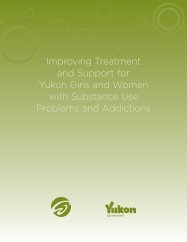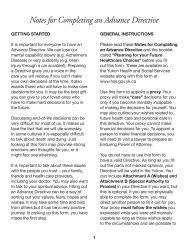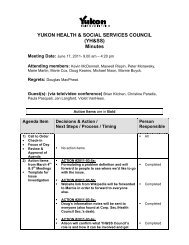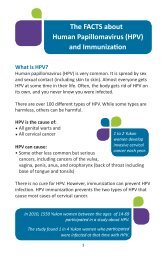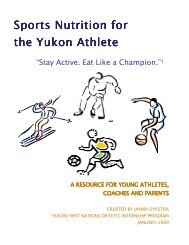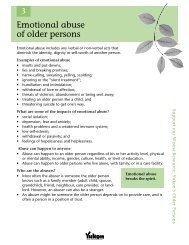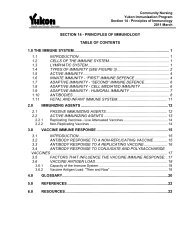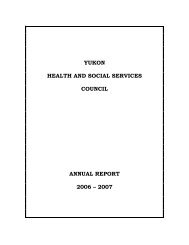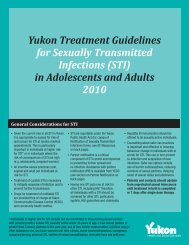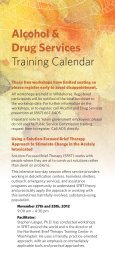Women and Alcohol: A women's health resource [2326.26 KB ]
Women and Alcohol: A women's health resource [2326.26 KB ]
Women and Alcohol: A women's health resource [2326.26 KB ]
You also want an ePaper? Increase the reach of your titles
YUMPU automatically turns print PDFs into web optimized ePapers that Google loves.
<strong>Women</strong> <strong>and</strong> <strong>Alcohol</strong><br />
3<br />
Harvard’s Lisa Najavits, author of Seeking<br />
Safety: A Treatment Manual for PTSD <strong>and</strong><br />
Substance Abuse: “The unseen alcohol<br />
problems of high-functioning women are<br />
serious.”<br />
“<strong>Women</strong> who are in their 40s <strong>and</strong> 50s<br />
have a very high risk in terms of heavy<br />
drinking, <strong>and</strong> weekly drinking,” says<br />
Katherine Keyes, a post-doctoral fellow at<br />
Columbia University in New York <strong>and</strong> coauthor<br />
of a study published in <strong>Alcohol</strong>ism:<br />
Clinical & Experimental Research.<br />
Having reviewed 31 international studies<br />
of birth-cohort <strong>and</strong> gender differences in<br />
alcohol consumption <strong>and</strong> mortality, she<br />
<strong>and</strong> her fellow authors concluded that<br />
younger groups, especially female, were<br />
increasingly at risk for developing alcoholrelated<br />
disorders. “Those born between<br />
1978 <strong>and</strong> 1983 are the weekend warriors,<br />
drinking to black out. In that age group,<br />
there is a reduction in male drinking, <strong>and</strong> a<br />
sharp increase for women.”<br />
Most importantly, the study points to<br />
the critical role of societal elements in<br />
creating a drinking culture. “Traditionally,<br />
individual biological factors have been the<br />
major focus when it comes to underst<strong>and</strong>ing<br />
risk,” says Keyes. “However, this ignores<br />
the impact of policy <strong>and</strong> environment.”<br />
The one protective factor for women? Lowstatus<br />
occupations. “Those in high-status<br />
occupations, working in male-dominated<br />
environments, have an increased risk of<br />
alcohol use disorders.”<br />
“This is a global trend: the richer a country,<br />
the fewer abstainers, the more women<br />
drink, <strong>and</strong> the smaller the gap between men<br />
<strong>and</strong> women,” says Jürgen Rehm, director of<br />
social <strong>and</strong> epidemiological research at the<br />
Centre for Addiction <strong>and</strong> Mental Health.<br />
“The new reality is that binge drinking has<br />
been increasing, especially among young<br />
adults, in modern high-economy countries<br />
— <strong>and</strong> women are largely responsible for<br />
this trend.”<br />
The prototypical example is the U.K.<br />
“There’s no country where women drink<br />
more than men,” adds Rehm, “but there are<br />
some surveys from the U.K. where they’re<br />
awfully close. <strong>Women</strong> weigh less, <strong>and</strong> are<br />
still smaller, so the same amount of alcohol<br />
leads to more intoxication. If you correct<br />
for body mass index, women <strong>and</strong> men are<br />
almost equal.”<br />
Says Keyes: “We’re not saying go back<br />
to the kitchen <strong>and</strong> put down the sherry.<br />
But when we see these steep increases,<br />
you wonder if we are going to see a larger<br />
burden of disease for women.”<br />
The answer in the U.K. — the Lindsay<br />
Lohan of the international set — is yes.<br />
There, a growing number of young women<br />
are presenting with liver cirrhosis. But<br />
Canadians underestimate the scale of the<br />
problem here. According to a 2007 study by<br />
the Canadian Centre on Substance Abuse,<br />
Canadians estimated that the costs related<br />
to illicit drugs were much higher than those<br />
related to alcohol. In fact, the opposite is<br />
true.<br />
<strong>Alcohol</strong> is Canada’s drug of choice,<br />
<strong>and</strong> it’s a lucrative one — if you look at<br />
one side of the ledger. In 2010, alcohol<br />
sales totalled $19.9 billion. However, the<br />
direct alcohol-related costs for <strong>health</strong> care<br />
<strong>and</strong> enforcement exceed the direct revenue<br />
from alcohol in most jurisdictions, Ontario<br />
included. “More than 80 per cent of our<br />
population over 15 drinks,” says Rehm,”<br />
which causes a lot of death. Economically,<br />
it is a much larger problem than smoking<br />
because alcohol-related deaths come much<br />
earlier. An average alcohol-related death is<br />
Jürgen Rehm says the richer the country, the more women drink.<br />
under 55 <strong>and</strong> that means it’s a combination<br />
of cancers, heart disease <strong>and</strong> injuries. By<br />
drinking, people are setting themselves up<br />
for morbidity <strong>and</strong> mortality issues.”<br />
In our society, alcohol is ubiquitous.<br />
Walk into most social gatherings, <strong>and</strong> the<br />
first question you’ll be asked is, “Red or<br />
white?” Knowing your wines is a mark<br />
of sophistication. So, too, is the ability<br />
to “hold your liquor.” We have a habit of<br />
“othering” those who have problems: the<br />
rare alcoholic, the skid-row drunk, the killer<br />
drunk.<br />
When it comes to alcohol, we live in a<br />
culture of denial. With alcoholics representing<br />
roughly two per cent of the population <strong>and</strong><br />
more than 80 per cent of us drinking, it’s<br />
the widespread normalization of heavier<br />
consumption that translates to a national<br />
<strong>health</strong> burden. The top 20 per cent of the<br />
heaviest drinkers consume 73 per cent of the<br />
alcohol in Canada. Episodic binge drinking by<br />
a large population of nondependent drinkers<br />
has a huge impact on the <strong>health</strong> <strong>and</strong> safety<br />
of the community. That larger group is well<br />
represented in the numbers missing work,<br />
getting injured or being hospitalized. When<br />
LUCAS OLENIUK/TORONTO STAR


![Women and Alcohol: A women's health resource [2326.26 KB ]](https://img.yumpu.com/22340649/3/500x640/women-and-alcohol-a-womens-health-resource-232626-kb-.jpg)
